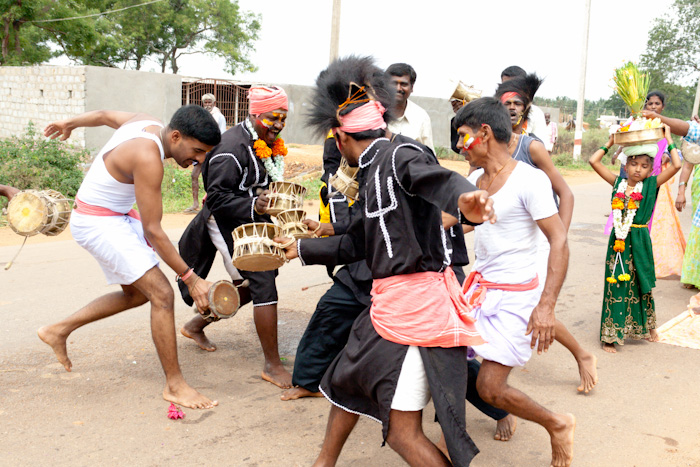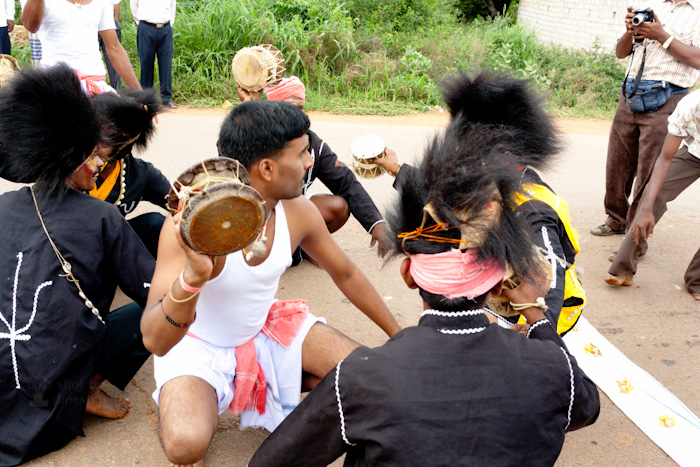
Any fair or a village event in many parts of Karnataka Goravas can be easily identified by their black or red dresses and a bearskin headgear and dancing with damaru ( a small drum like percussion ) in their hand . They are devotees of Lord Mylaralinga . Kurubas or men from Shepherd family in Karnataka dedicate themselves to Lord Mylaralinga and start learning this folk form before their marriage. They dance in their unique style in village fairs, or spiritual functions and bless people. When Goravas bless children it is believed that fear is ridden from body and mind.
Recently when I was attending a fair near Nittur, Karnataka I saw Gorava dancers performing a unique rituals during the procession. A devotee laid a mixture of jackfruit and rice ( not boiled ) on a white cloth on the ground. All the members of Gorava team started dancing around it and as they danced they closed in. After a minute of dance they jumped on ground and ate all the mixture of Jackfruit and rice after grabbing directly from mouth . Then as they ate them they continued their dance .







Gorava dance is a very old traditional folk form of Karnataka which is in a dying stage like many other folk arts of Karnataka. Nowadays these can be seen only in some fairs and temples . Many Gorava dancers doing part time agriculture jobs in order to full fill their needs . One day we might just left with some pictures like these and Gorava dance can be read only in text books.
This story is part of my ongoing project ” Folk practices of Karnataka” from years. There is a need of visual documentation of these practices as most of the practices are either dying or changing due to modern metamorphosis . I am not in the favor of starting a debate whether these practices are good or bad and it is not up to my current knowledge . So please consider this body of work as photo-documentation of the practices.
How you can help me ?
- By reading these articles, looking at photos and sending me feedback, suggestions .
- By spreading these articles to the world by sharing on social networks , emails etc so that an awareness is created
- By Letting me know such practices in your region, reach if you think it deserves a visual record provided the region is Karnataka. You can send email to folkpractices@dineshmaneer.com and I will take necessary steps.
- By publishing the articles in your dailies , magazines, books etc which will benefit both financially as well as reaching people
- By buying photos, prints, offering me shelter 😉 when I am at your place for photographing .
ಇಲ್ಲಿ ಬರುವ ಲೇಖನಗಳು ಮತ್ತು ಛಾಯಾಚಿತ್ರಗಳು ನನ್ನ ” ಕರ್ನಾಟಕದ ಜನಪದ ಆಚರಣೆಗಳು” ಎಂಬ ಪ್ರಾಜೆಕ್ಟ್ ನ ಭಾಗಗಳಾಗಿವೆ. ಶತಮಾನಗಳಿಂದ ಆಚರಣೆಯಲ್ಲಿರುವ ಈ ನಶಿಸುತ್ತಿರುವ ಸಂಸ್ಕೃತಿಗಳನ್ನು ಚಿತ್ರಗಳಲ್ಲಿ ಹಿಡಿದಿಡುವ ಪ್ರಯತ್ನವನ್ನು ಕಳೆದ ಎರಡು ವರುಶಗಳಿಂದ ಮಾಡುತ್ತಿದ್ದೇನೆ . ಈ ಆಚರಣೆಗಳು ಸರಿಯೋ ತಪ್ಪೋ ಎನ್ನುವುದನ್ನು ಸಾರುವ ಉದ್ದೇಶ ನನ್ನದಲ್ಲ. ಅಲ್ಲದೇ ಅದು ನನ್ನ ಸದ್ಯದ ತಿಳುವಳಿಕೆಗೆ ಎಟುಕದ ವಿಷಯ. ಓದುಗರು ದಯವಿಟ್ಟು ಈ ಪ್ರಯತ್ನವನ್ನು ಆಚರಣೆಗಳ ಪರ ಹಾಗು ವಿರೋಧದ ಚರ್ಚೆಯಾಗಿ ತೆಗೆದುಕೊಳ್ಳದೆ ಇವುಗಳ ದೃಶ್ಯದಾಖಲೆಯಾಗಿ ಪರಿಗಣಿಸಬೇಕು ಎಂಬುದು ನನ್ನ ವಿನಂತಿ.
ನೀವು ಹೇಗೆ ನನಗೆ ಸಹಾಯ ಮಾಡಬಹುದು?
1) ಈ ದೃಶ್ಯಲೇಖನವನ್ನು ಓದುವುದರ ಮೂಲಕ , ಸಲಹೆಗಳನ್ನು ಕೊಡುವುದರ ಮೂಲಕ, ಪ್ರತಿಕ್ರಿಯೆಗಳನ್ನು ಕೊಡುವುದರ ಮೂಲಕ
2) ನಿಮ್ಮ ಗೆಳೆಯ ಬಂಧುಗಳಲ್ಲಿ ಈ ಕೊಂಡಿಯನ್ನು (link) ಹಂಚಿಕೊಳ್ಳುವುದರ ಮೂಲಕ
3) ನಿಮ್ಮ ಸನಿಹದಲ್ಲಿ ಈ ತರಹದ ಯಾವುದಾದರು ಅಚರಣೆಗಳಿದ್ದಲ್ಲಿ ಅವುಗಳನ್ನು ತಿಳಿಸುವುದರ ಮೂಲಕ
4) ಪತ್ರಿಕೆಗಳಲ್ಲಿ , ಸಾಪ್ತಾಹಿಕಗಳಲ್ಲಿ , ಮಾಸಿಕಗಳಲ್ಲಿ ಪ್ರಕಟಿಸುವುದರ ಮೂಲಕ, ಪುಸ್ತಕಗಳಲ್ಲಿ ಪ್ರಕಟಿಸುವುದರ ಮೂಲಕ
5) ಛಾಯಾಚಿತ್ರಗಳನ್ನು , ಚಿತ್ರಮುದ್ರಣಗಳನ್ನು ಖರೀದಿಸುವದರ ಮೂಲಕ-thank you
Dinesh Maneer